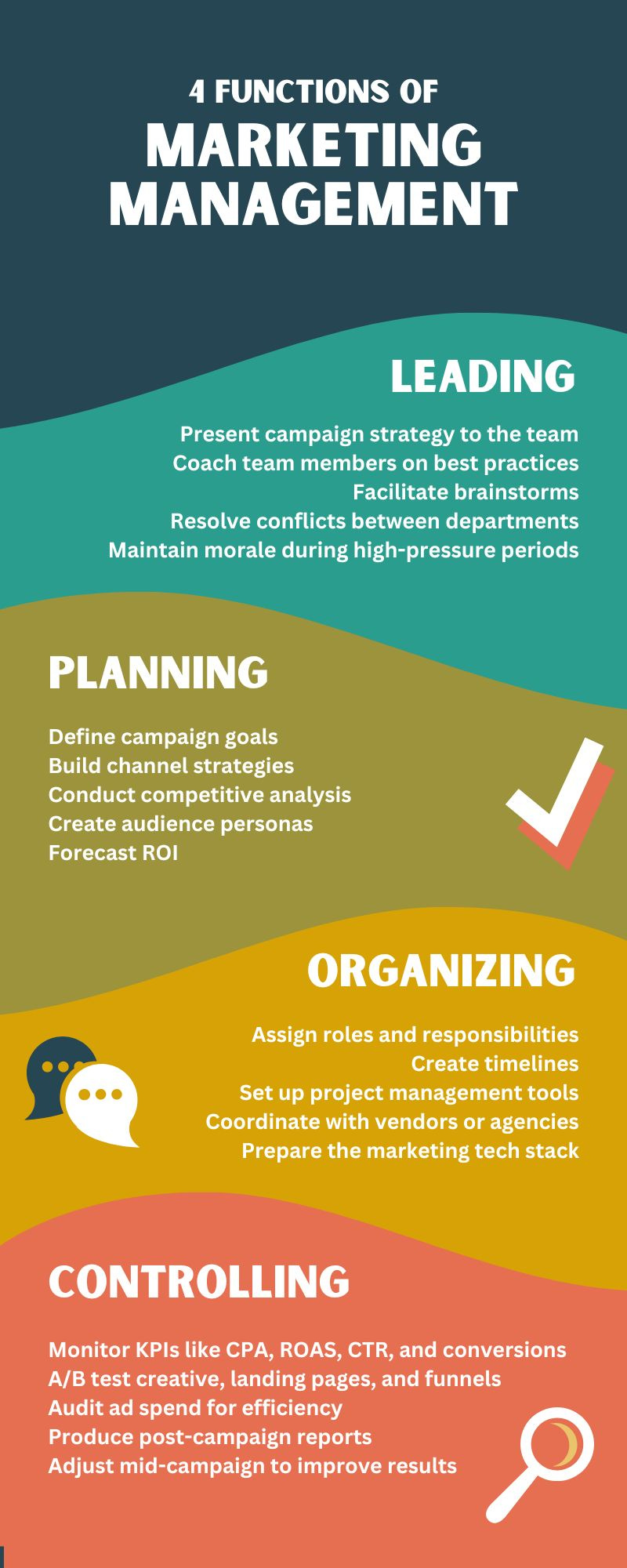Marketers Who Master These 4 Skills Drive 48% Higher Profits
The four functions of management aren’t just theory — they’re the daily blueprint top marketers use to plan, execute, and deliver measurable results.
Believe it or not, this is one of the few business models I mentally reference almost every single day. If I could go back to my younger self, I’d tell younger Kris to learn this sooner, use more sunscreen, and grow your hair long while you still have it.
The four functions of management, planning, organizing, leading, and controlling, might sound like something pulled from a stuffy business textbook, but in reality, this is the framework behind almost every successful project, campaign, or business decision I’ve made. Once you understand them, you start to see them everywhere. And if you work in marketing, you quickly realize that the people who excel in their careers are the ones who execute all four functions consistently, no matter their title.
Strong managers who master these skills bring measurable results. Gallup found that talented managers drive 48% higher profit compared to average ones. Performance-management leaders see 67% better employee performance. And managers account for 70% of the variance in team engagement, an engaged team delivers more, faster, and better.
If great managers seem scarce, it's because the talent required to be one is rare. Gallup's research reveals that about one in 10 people possess the talent to manage. …It's important to note that another two in 10 people exhibit some characteristics of basic managerial talent and can function at a high level if their company invests in coaching and developmental plans for them. - Gallup
A well-rounded professional doesn’t just dabble in these functions. They plan, organize, lead, and control like second nature. And it shows… managers who can competently perform these functions, stand out from their peers.
Here’s how I see each function, why it matters, and the marketing activities that live inside each.
Planning
This is about setting the direction before you start moving. You define where you’re going, why, and how you’ll measure success. Each year for the past 10 years I’ve created an annual marketing plan which has been key in establishing direction, role clarity, and how each person can contribute to the company goals.
Marketing activities that fall under planning:
Defining campaign goals (e.g. “Increase email subscriber base by 25% in Q2”)
Building channel strategies (deciding how much budget goes to search, social, display, or email)
Conducting competitive analysis to identify gaps and opportunities
Creating audience personas and mapping the customer journey
Forecasting campaign ROI based on historical performance
When I plan well, I avoid chasing vanity metrics and keep my campaigns focused on the numbers that matter to the business.
Organizing
Once you have the plan, you need to set up the structure to make it happen. This is where you align people, tools, and timelines so execution runs smoothly.
Marketing activities that fall under organizing:
Assigning roles for creative, copywriting, ad buying, analytics, and reporting
Creating campaign timelines and Gantt charts
Setting up project management tools like Asana, Trello, or Jira for visibility
Coordinating with external vendors, agencies, or freelancers
Preparing the marketing tech stack (CRM integrations, ad account setups, tracking pixels)
If organizing is skipped, even the best ideas can collapse under missed deadlines, unclear ownership, or tech issues that could have been avoided.
Leading
This is the human side of management. Leading means motivating, guiding, and removing roadblocks for the people involved in executing the plan.
Marketing activities that fall under leading:
Presenting campaign strategy to the team in a way that builds excitement and clarity
Coaching team members on best practices for their channels
Facilitating creative brainstorms to spark new ideas
Resolving conflicts or misalignments between departments (e.g. creative and product)
Keeping morale high during crunch periods with recognition, encouragement, and clear priorities
Leading well means your team not only delivers but wants to deliver. I’ve seen campaigns hit impossible deadlines because the team was united and motivated.
Bonus: I also reference Jack Welch’s 4E’s and a P. I think it helps make the leading function a little more tangible.
Controlling
Controlling is about ensuring your results match your plan. It’s measurement, analysis, and adjustment.
Marketing activities that fall under controlling:
Monitoring KPIs like CPA, ROAS, CTR, and conversion rate in real time
Running A/B tests on creative, landing pages, and messaging
Auditing ad spend to ensure budget is used efficiently
Producing post-campaign reports with actionable insights
Implementing changes mid-campaign if metrics fall short of targets
In marketing, controlling often separates average campaigns from great ones. A 5% improvement in CTR or a drop in CPA by $50 can be the difference between scaling a campaign or shutting it down.
My Criticism of The 4 Functions of Management
One valid criticism of the four functions of management framework is that it does not explicitly call out communication, which I believe is easily half of what business administration actually is. Planning, organizing, leading, and controlling all rely on the ability to communicate clearly, consistently, and persuasively. Without strong communication, even the best plans can fall apart, teams can lose direction, and performance tracking becomes meaningless. In practice, communication is not a separate “fifth function”, it is the connective tissue that allows the other four to work.
Why I Keep Coming Back to This Model
I have led marketing teams, managed multi-million-dollar budgets, and rebuilt entire brand platforms, and I still run my work through these four functions. They’re a checklist, a framework, and a gut check all in one.
If you’re early in your career, learn these now. If you’re mid-career, sharpen them. If you’re leading a team, teach them. Because once you can plan effectively, organize resources, lead people, and control results, you’re not just “doing marketing.” You’re running it like a business. And that’s where the real impact happens.




